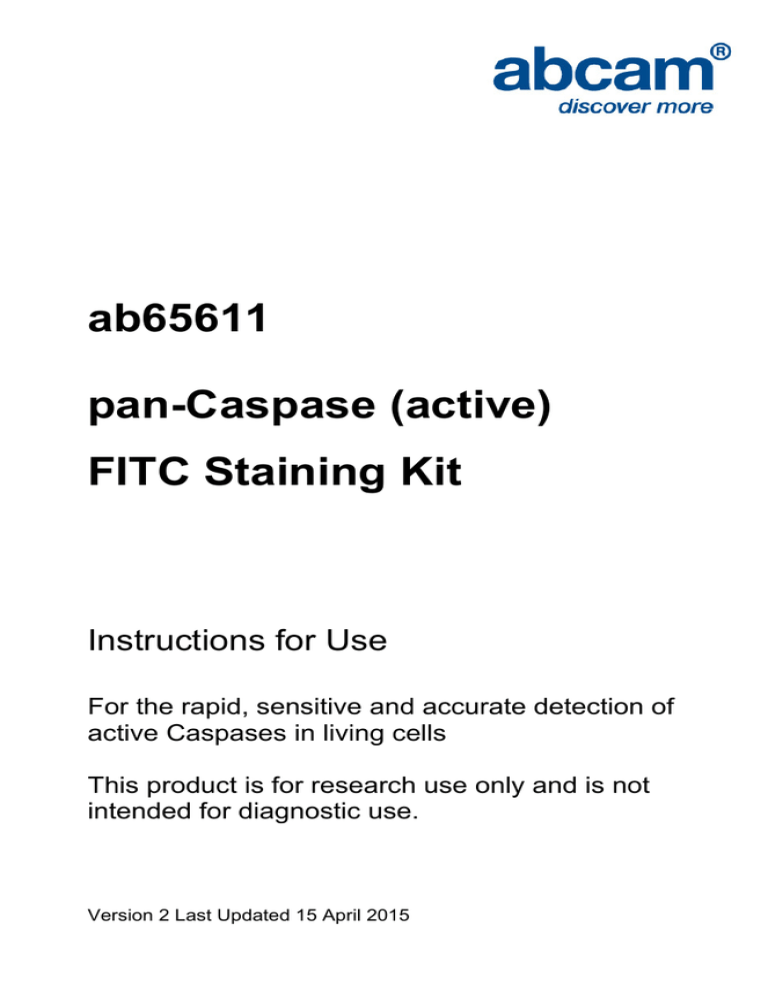
ab65611
pan-Caspase (active)
FITC Staining Kit
Instructions for Use
For the rapid, sensitive and accurate detection of
active Caspases in living cells
This product is for research use only and is not
intended for diagnostic use.
Version 2 Last Updated 15 April 2015
Table of Contents
1.
Overview
2
2.
Protocol Summary
2
3.
Components and Storage
3
4.
Assay Protocol
4
5.
Troubleshooting
6
1
1. Overview
Activation of Caspases plays a central role in apoptosis. Abcam’s
pan-Caspase (active) FITCStaining Kit provides a convenient and
sensitive means for detecting activated Caspases in living cells. The
assay utilizes the Caspase family inhibitor VAD-FMK conjugated to
FITC (FITC-VAD-FMK) as a marker. FITC-VAD-FMK is cell
permeable, nontoxic, and irreversibly binds to activated Caspases in
apoptotic cells.
2. Protocol Summary
Induce Apoptosis in Cell Samples
Add FITC-VAD-FMK
Analyze by Flow Cytometry
OR
Detect by Fluorescence Microscopy
OR
Measure Fluorescence in Microplate Reader
2
3. Components and Storage
A. Kit Components
Item
Quantity
FITC-VAD-FMK
100 μL
Wash Buffer
2 x 100 mL
Z-VAD-FMK
10 μL
* Store kit at -20°C.
B. Additional Materials Required
Microcentrifuge
Pipettes and pipette tips
Fluorescent microplate reader or microscope
Flow cytometer
Black microtiter plate
Orbital shaker
3
4. Assay Protocol
1. Sample Preparation:
a) Induce apoptosis in cells (1 x 106/ml) by desired method.
Concurrently incubate a control culture without induction.
An additional negative control can be prepared by adding the
Caspase inhibitor Z-VAD-FMK at 1 μl/ml to an induced culture to
inhibit Caspase activation.
Notes:
This product detects proteolytic activity. Do not use protease
inhibitors in the sample preparation step as it might interfere
with the assay.
b) Aliquot 300 μl each of the induced and control cultures into
eppendorf tubes.
c) Add 1 μl of FITC-VAD-FMK into each tube and incubate for 0.5-1
hour at 37°C incubator with 5% CO2.
d) Centrifuge cells at 3000 rpm for 5 minutes and remove
supernatant.
e) Re-suspend cells in 0.5 ml of Wash Buffer, and centrifuge again.
f) Repeat Step e.
4
g) Proceed to Step 2, 3 or 4 depending on methods of analysis.
2. Quantification by Flow Cytometry:
For flow cytometric analysis, re-suspend cells in 300 μl of Wash
Buffer. Keep samples on ice. Analyze samples by flow cytometry
using the FL-1 channel.
3. Detection by Fluorescence Microscopy:
For fluorescence microscopic analysis, re-suspend cells in 100 μl
Wash Buffer. Put one drop of the cell suspension onto a microslide
and cover with a coverslip.
Observe cells under a fluorescence microscope using FITC filter.
Caspase positive cells appear to have brighter green signals,
whereas Caspase negative control cells show much weaker signal.
4. Analysis by Fluorescence Plate Reader:
For analysis with fluorescence plate reader, re-suspend cells in
100 μl Wash Buffer and then transfer the cell suspension to each
well in the black microtiter plate.
Measure the fluorescence intensity at Excitation = 485 nm and
Emission = 535 nm. For control, use wells containing unlabeled
cells.
5
5. Troubleshooting
Problem
High
Background
Reason
Solution
Cell density is
Refer to datasheet and use the
higher than
suggested cell number
recommended
Increased volumes
of components
added
Incubation of cell
samples for
extended periods
Lower signal
levels
Use calibrated pipettes
accurately
Refer to datasheets and
incubate for exact times
Use of extremely
confluent cells
Perform assay when cells are at
80-95% confluency
Contaminated
cells
Check for bacteria/ yeast/
mycoplasma contamination
Cells did not
initiate apoptosis
Very few cells
used for analysis
Incorrect setting of
the equipment
used to read
samples
Use of expired kit
or improperly
stored reagents
Determine the time-point for
initiation of apoptosis after
induction (time-course
experiment)
Refer to data sheet for
appropriate cell number
Refer to datasheet and use the
recommended filter setting
Always check the expiry date
and store the components
appropriately
6
Erratic
results
Uneven number of
Seed only healthy cells (correct
cells seeded in the
passage number)
wells
Adherent cells
dislodged at the
time of experiment
Incorrect
incubation times or
temperatures
Perform experiment gently and
in duplicates or triplicates for
each treatment
Refer to datasheet & verify
correct incubation times and
temperatures
Incorrect volumes
used
Use calibrated pipettes and
aliquot correctly
For further technical questions please do not hesitate to
contact us by email (technical@abcam.com) or phone (select
“contact us” on www.abcam.com for the phone number for
your region).
7
8
9
10
UK, EU and ROW
Email: technical@abcam.com | Tel: +44(0)1223-696000
Austria
Email: wissenschaftlicherdienst@abcam.com |
Tel: 019-288-259
France
Email: supportscientifique@abcam.com | Tel: 01-46-94-62-96
Germany
Email: wissenschaftlicherdienst@abcam.com | Tel: 030-896-779-154
Spain
Email: soportecientifico@abcam.com | Tel: 911-146-554
Switzerland
Email: technical@abcam.com
Tel (Deutsch): 0435-016-424 | Tel (Français): 0615-000-530
US and Latin America
Email: us.technical@abcam.com | Tel: 888-77-ABCAM (22226)
Canada
Email: ca.technical@abcam.com | Tel: 877-749-8807
China and Asia Pacific
Email: hk.technical@abcam.com | Tel: 108008523689 (中國聯通)
Japan
Email: technical@abcam.co.jp | Tel: +81-(0)3-6231-0940
www.abcam.com | www.abcam.cn | www.abcam.co.jp
Copyright © 2015 Abcam, All Rights Reserved. The Abcam logo is a registered trademark.
All information / detail is correct at time of going to print.



